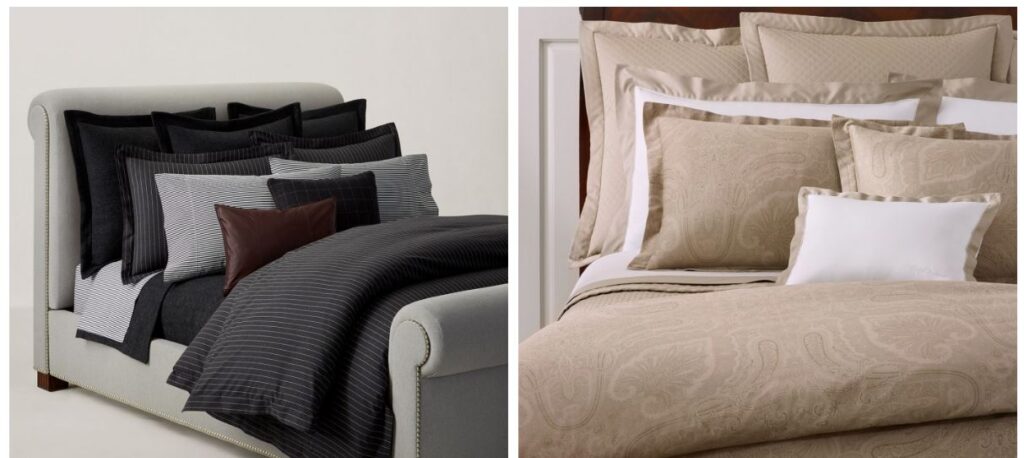
A subtle yet incredibly fashionable makeover is taking place in homes all over the United Kingdom, starting in the bedroom. Surprisingly, affordable designer bedding has emerged as the newest way to live in style without having to worry about expensive prices. Thanks to carefully lowered costs and more competitive retail options, luxury linen—once a sign of upscale comfort—is now being reimagined as an affordable upgrade.
High-end bedding has significantly changed over the last three years, moving from boutique exclusivity to widespread accessibility. A few extremely powerful forces—retailer partnerships, overstock clearance, and flash sale platforms that provide designer items at up to 80% off—have been responsible for this shift, which is especially noticeable in the UK market. Things that used to cost a small fortune now frequently arrive at your door for a surprisingly low cost.
Discount Designer Bedding UK – Quick Facts
| Feature | Details |
|---|---|
| Common Retailers | BrandAlley, Bedeck, John Lewis, TK Maxx, Julian Charles, JustLinen |
| Brand Names Featured | Ralph Lauren, Yves Delorme, Christy, Kenzo, Sanderson, DKNY, Missoni |
| Typical Discount Range | From 20% to 80% off retail price |
| Fabric Types Offered | Egyptian Cotton, Linen, Bamboo, Sateen, Percale |
| Popular Sizes | Single, Double, King, Super King, Emperor |
| Thread Counts Available | Ranging from 200 to 1200 depending on brand and collection |
| Where to Buy Online | yvesdelormeoutlet.com, bedeckhome.com, brandalley.co.uk |
| Seasonal Promotions | Heaviest discounts during summer and Boxing Day sales |
| Standout Offers | £209 sheets for £83.60; 70% off Missoni Home patterns |
| Delivery Options | Free UK delivery available on most platforms |
Retailers like BrandAlley and Bedeck have created an amazing assortment of luxury brands by taking advantage of seasonal changes and the availability of bulk stock, bringing previously unattainable styles as close as your smartphone. Known for their crisp percale finish, Ralph Lauren’s classic bedding sets are often priced under £90, which is a significant discount from their original retail listing of £205. In addition to being attractive, this type of discount has significantly increased in frequency and scope when compared to a few years ago.
Comfort became a top concern during the pandemic. Bedrooms evolved into havens rather than places to sleep. Customers in the UK started spending money on textures that felt as good as they looked at that point. With options ranging from breathable bamboo-linen blends to silky sateen weaves, consumers found that bedding could serve as a wellness anchor and a very personal touchpoint during a period of widespread stress.
One Brighton woman remembered purchasing a 60% off Yves Delorme sateen duvet cover during a summer flash sale. She emphasized the emotional significance that many people place on sleeping areas today when she said that getting into bed that night was “the closest thing to a spa I’ve felt at home.” Once considered a luxury, that duvet is now a daily necessity for her.
These retailers have become extremely effective at providing high-end products in a timely and cost-effective manner by utilizing direct-to-consumer channels and clever logistics. For example, Julian Charles now sells vintage-inspired sets with embroidery or flowers at over 50% off with next-day delivery. This is a great option for renters on a tight budget or newlyweds furnishing their first apartment.
Designer duvets, pillows, and sheets made of Egyptian cotton or high-thread-count sateen—often 1000 or more—are now widely available. The DKNY, Christy, and V&A collections that formerly graced five-star hotel rooms are now available to customers at Bedeck at more affordable costs. In addition to being aesthetically pleasing, these products are incredibly resilient, holding their texture and sheen through years of washing.
Previously an ambiguous marketing term, thread count has evolved into a significant indicator of quality. Choosing between an 800-thread-count and 200-thread-count sheet now feels as intentional to many as selecting skincare products. Despite its technicality, this comparison shows how much consideration buyers are giving to sleep-enhancing products.
Perfectly styled beds have been the focal point of Instagram bedroom showcases by influencers and designers alike in recent months. A new aspirational lifestyle that doesn’t require shelling out £500 for a single bedding set has been spawned by hashtags like #linenlove and #bedroomgoals. Sets that used to cost more than a weekend getaway can now be purchased for the price of dinner for two thanks to strategically timed markdowns.
The most intriguing aspect of this shopping behavior may be how it represents a broader cultural change. These sales offer a surprisingly clever solution for first-time homeowners or renters who want to upgrade their interiors without breaking the bank. You no longer have to choose between price and luxury.
The home division of TK Maxx has been especially creative by providing pop-up sales on high-end designer cushions and duvets. These items change every week and frequently sell out within hours of being restocked, making bedding shopping an unexpectedly exciting and competitive activity. Citing a Missoni duvet that was reduced from £240 to £69 and that totally transformed the aesthetic of her minimalist bedroom, one customer compared it to discovering treasure.
Sustainability and the growing desire for reasonably priced luxury are related. Outlet shopping and clearance sales naturally cut down on waste. Instead of throwing away unsold inventory, brands are reusing it, frequently with fresh enthusiasm from younger, fashion-forward consumers. These retailers are encouraging more deliberate and intelligent consumption by prolonging the life of each product.
Retailers have created collections that offer lifestyle alignment rather than just sheets thanks to strategic alliances and trend-conscious designs. Bedding is now discussed in relation to wellness, slow living, and self-care. The distinction between practical utility and personal luxury becomes increasingly hazy as influencer culture and interior design blend together.
